Which franchise wound up with the best Konami Arcade Beat ‘em Up? Let’s run the numbers!
Teenage Mutant Ninja Turtles (1989)
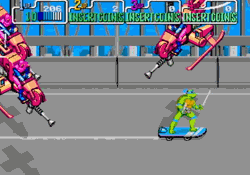 • The quintessential beat ‘em up: this is the licensed arcade game that defined the genre, and arcades, for years to come
• The quintessential beat ‘em up: this is the licensed arcade game that defined the genre, and arcades, for years to come
• It’s four players, which is always a fun time for everybody. There is no friendly fire, and there are no tangible rewards for scoring better than another player. This is a friendly, cooperative beat ‘em up.
• … Except when your buddy steals a life-restoring pizza out from under you. Then it is on. Let’s take this discussion to the Mortal Kombat cabinet.
• For better or worse, all of the turtles control almost exactly the same. A dedicated herpetologist can probably explain the nuances between a Donny and a Raph, but that’s mostly cosmetic. Four playable characters that may as well be color-swaps of each other.
• Meanwhile, there is a fairly large roster of opponents, they just all look identical. The hoards of Foot Soliders besieging the turtles are nearly all indistinguishable, but their different weapons lead to different attack patterns.
• Past Foot Soliders, there are, like, two other enemies.
• You can fight a sentient brain in a robot wrester’s body.
• Occasionally, there are exploding barrels.
• The skateboarding stage is the most radical thing that happened in 1989.
• TMNT: Turtles in Time should really count toward the turtles’ final score, but playing that game now unearths traumatic memories.
Teenage Mutant Ninja Turtles Final Ranking: Two Players out of Four.
X-Men (1992)
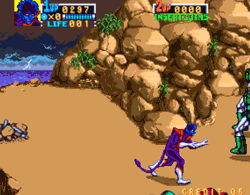 • Six players! It’s double wide for double the fun! … Or at least 50% more wide.
• Six players! It’s double wide for double the fun! … Or at least 50% more wide.
• A handful of “extra” offensive options are available. Most important: you can kick opponents when they’re down. This offers a fun way to gamble on dealing damage (do you target a downed opponent but risk reprisal from the enemies still standing?), and also gives the impression that Scott Summers walks around kicking lizardmen in the junk.
• Characters are varied in visual style as well as special moves. Their common movesets are generic, but those mutant powers? Nobody is going to mistake the frantic teleporting of Nightcrawler for the power surges of Colossus.
• Offers the ultimate in Canadian entertainment: Wolverine versus The Wendigo.
• There are many of the same robots over and over, but there are also plant/dirt monsters, cyborg marauders, tiny dinosaur people, and at least one swarm of angry, robotic bees.
• No Nasty Boys, though.
• You don’t get more iconic than “Nothing moves The Blob!”
• Okay, maybe, “X-Men, welcome to die!” But Blob sells his declarations better than Magneto.
• The extra “mutant power orb” is confusing at best, and a psychological trick designed to ruin a player’s health at worst. It… just doesn’t work that well on any level.
• Only the Japanese version offers health powerups. Nary a pizza to be found for the X-Men.
X-Men Final Ranking: 120 mighty mutants out of a possible 198.
Bucky O’Hare (1992)
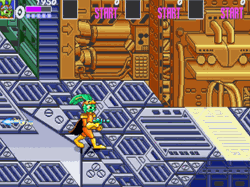 • This is what we in the biz (there is no biz) call a pseudo-beat ‘em up. All the beat ‘em up trappings are there, but this game is much more shooter than beat ‘em up. This is the unholy combination of Contra and Final Fight.
• This is what we in the biz (there is no biz) call a pseudo-beat ‘em up. All the beat ‘em up trappings are there, but this game is much more shooter than beat ‘em up. This is the unholy combination of Contra and Final Fight.
• And, uh, that’s pretty great.
• However, some of the genre trappings are a little confused, so, for instance, you take damage for simply touching an opponent, which is a bit of a rub in a game that is already a deliberate quarter killer.
• But still, bang bang shoot shoot.
• The playable characters are visually varied, but there are very few practical difference between the cast. This is particularly egregious when at least one of your possible choices is a four-armed space pirate duck.
• Two stages scroll vertically, and a few areas completely descend into shoot ‘em ups. Added variety, or diving into a genre no one asked for? Take your pick.
• The mooks of the Bucky O’Hare universe were never that interesting to begin with, so mowing down waves of identical frogs is less than satisfying.
• Technically created by Larry Hama.
• You’re not allowed to play as Bruce the Betelgeusian Berserker Baboon or, to a dramatically lesser extent, Willy DuWitt.
• Apparently developed by the team that would eventually become Treasure, but I don’t buy it, because there isn’t an exhaustingly long boss rush anywhere in the game.
Bucky O’Hare Final Ranking: 75% of a thinly veiled metaphor for modern consumer culture that absolutely nobody understood because it was immediately merchandised to all hell.
Asterix (1992)
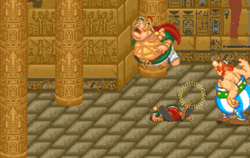 • Only two players.
• Only two players.
• Friendly fire is enabled, which I’m sure seemed like a good idea at the time.
• Asterix and Obelix are very different characters, though with interchangeable controls. They’re simultaneously extremely different but immediately understandable.
• Possibly the most gameplay variety in a Konami licensed beat ‘em up. The Teenage Mutant Ninja Turtles can only dream of chariot racing.
• Literally tossing around your opponents like ragdolls is always going to be fun.
• Opponents can be beaten while they’re down for the all-important purpose of smacking them against other, slightly more conscious enemies.
• Powered up punches are a logical extension of other titles’ super moves, and feel appropriately cartoony.
• Unfortunately, some bosses necessitate powered up punches for a final coup de grâce, and outright requiring a player to do anything in an arcade setting is a black mark against fun.
• Very unfortunately only available in Europe or locally at that one arcade owned by that Agnieszka person… and Agnieszka seems pretty sketchy.
Asterix Final Ranking: Disqualified for not being American enough. Grab some apple pie and get back to our judge’s panel.
The Simpsons (1991)
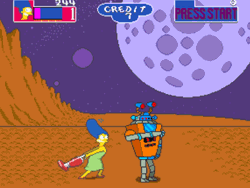 • Four players, and all four are the prime members of the titular Simpsons family. No being stuck with Dazzler here.
• Four players, and all four are the prime members of the titular Simpsons family. No being stuck with Dazzler here.
• Basic attacks and special moves both differentiate the characters. No one is mistaking Marge’s vacuum cleaner or butt bump for El Barto’s skateboard skill.
• Weapons and items are available frequently across multiple stages. A hammer may be used to brutalize teacups, and Lisa is allowed to fire a slingshot at the Burns Army. The Japanese version even offers the occasional nuclear bomb.
• The Simpsons may combine powers, thus meaning there’s a better reason than usual to encourage additional players to come and bond. What’s more, attract mode and a boss both clue the player into how to properly join forces.
• There are more background gags in this game than most modern episodes of The Simpsons.
• Despite the fairly mundane setting (evil billionaire kidnaps baby, tale as old as time), the various levels are varied and interesting. Moe’s Bar might be a bit longer than it ever appeared in the series proper, but the nearby graveyard is a blast, and the television station includes more robots and ninja than one would expect. The Dream World is the pinnacle, complete with unique enemies, objects, and a bowling ball boss.
• There are two bonus stages that give a humble player the opportunity to completely mangle some poor arcade owner’s buttons. Sorry, Agnieszka.
The Simpsons final ranking: Well, this one is hard to judge, as…
Wait a minute… We have some late-breaking news…
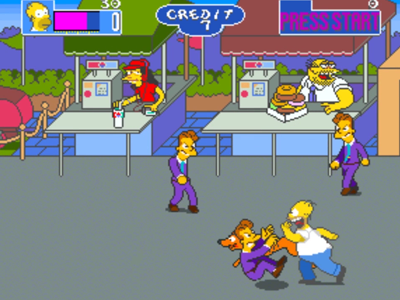
Apparently you can throw a dog at your opponents in The Simpsons, and said dog is just happy to be there throughout the hurling.
Okay, yes, The Simpsons unequivocally wins this competition. Don’t have a cow, man, that’s just how it is.
FGC #510 The Simpsons (Arcade)
- System: Arcade, but briefly available on Playstation network for the PS3, and Xbox Live for the Xbox 360. It likely disappeared again, though.
- Number of Players: Four Simpsons. Sorry, Maggie, you have to be the macguffin this time.
- Port-o-Call: There’s also a MS-DOS version of The Simpsons, and… Well, it’s from that same school of weird photocopying that led to the Mega Man DOS ports. It looks completely correct (for a DOS port from the early 90s), but it feels incredibly wrong (for anything ever). Jump once in that game, and you’ll turn it off in favor of MAME immediately.
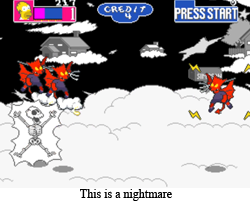 Across the Sea: The Japanese version includes more “weapons”, and hidden spots throughout levels that award fruit and alike. Whether this is because that version was released later or because Konami thought its native players needed more incentive to play a Simpsons game is unknown. What’s important is that Lisa can launch random cherry bombs against opponents, and that’s always fun.
Across the Sea: The Japanese version includes more “weapons”, and hidden spots throughout levels that award fruit and alike. Whether this is because that version was released later or because Konami thought its native players needed more incentive to play a Simpsons game is unknown. What’s important is that Lisa can launch random cherry bombs against opponents, and that’s always fun.- Goggle Bob Fact: My grandfather was always happy to provide quarters for his grandson, but was not happy with that Bart character casually utilizing the word “hell”. He would not have granted The Simpson this great beat ‘em up honor (he might have defaulted to Bomberman).
- Favorite Simpson (this game): Marge. I just think she’s neat.
- Did you know? There is more than a passing similarity between the final boss of The Simpsons and the final boss of Bucky O’Hare. In both cases, you’re battling the antagonist of the series as a hulking robot that gradually loses parts and morphs into different fighting modes. Then again, maybe this is just a trope of action games, as every game from Smash TV to Three Dirty Dwarves pulls a similar trick.
- Would I play again: This is the most fun you can have with a Konami beat ‘em up. So says Goggle Bob, who will inevitably play this game with or without friends again. Give it a few months.
What’s next? Random ROB has chosen… Pokémon Gold for the Nintendo Gameboy! That’s the gold standard for Gameboy titles! Please look forward to it!
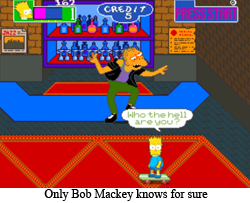

[…] finding switches across the world, then standing up to a dude that patterns his attacks after Teenage Mutant Ninja Turtles: The Arcade Game’s […]